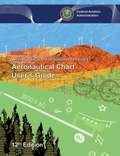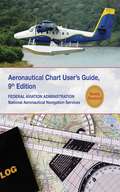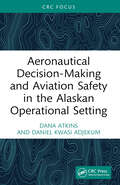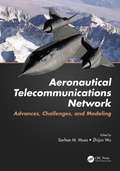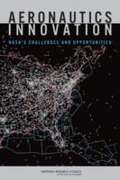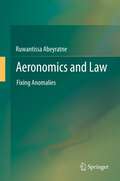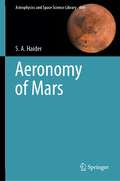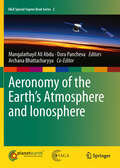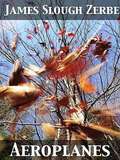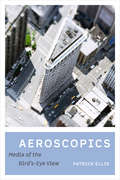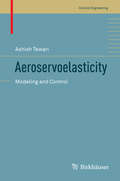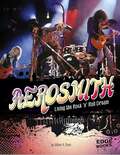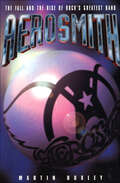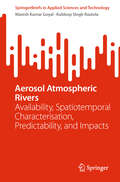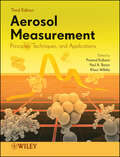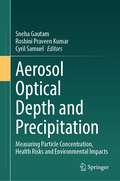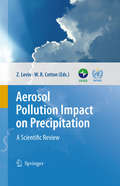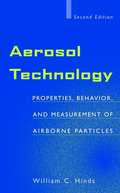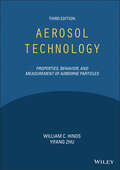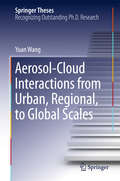- Table View
- List View
Aeronautical Chart User's Guide: Aeronav Products (FAA Handbooks Ser.)
by Federal Aviation AdministrationThe updated 11th edition of the Aeronautical Chart User’s Guide by the FAA is a great reference for novice pilots and professionals alike. Printed in full color with detailed examples, this book provides all the information students and pilots need to know about all the symbols and information provided on US aeronautical charts and chart navigation publications. Readers will find information on VFR charts, aeronautical chart symbols, helicopter route charts, flyway planning charts, IFR enroute charts, explanation of IFR enroute terms and symbols, Terminal Procedure Publications (TPPs), explanation of TPP terms and symbols, airspace classifications, and an airspace class table.
Aeronautical Chart Users Guide: National Aeronautical Navigation Services
by Federal Aviation AdministrationA critical reference tool for any aeronautical navigator, the ninth edition of the Aeronautical Chart User's Guide presents the most up-to-date information on charts adhering to Visual Flight Rule (VFR) and Instrument Flying Rule (IFR). Hundreds of color images throughout the book are paired with easy-to-understand explanations and definitions. This concise guide allows pilots and students to successfully pre-plan flight paths through any type of environment from man-made obstacles to natural terrain. In addition, the updated Aeronautical Chart User's Guide is a great study aid for current pilots who are preparing for additional certification and for potential pilots who are interested in applying for their first license.
Aeronautical Decision-Making and Aviation Safety in the Alaskan Operational Setting
by Daniel Kwasi Adjekum Dana AtkinsAeronautical Decision-Making and Aviation Safety in the Alaskan Operational Setting introduces the reader to the real-life experiences of aviators who fly in remote settings such as Alaska in the United States. It covers the challenges related to limited aviation infrastructure and support that affect human factors like aeronautical decision-making and its impact on aviation safety.Through a unique blend of meticulous case study analysis and semi-structured interviews with Alaskan pilots, this book offers a comprehensive understanding of the proverbial challenges of flying in Alaska. It uncovers the human factors elements specific to this environment, shedding light on the factors that influence a pilot’s decision-making, which may contribute to the high rate of accidents in Alaska and other remote regions. The content is supported by historical and socioeconomic perspectives on remote-setting aviation operations. Global perspectives are discussed with narratives from one author’s experiences flying to remote airstrips in Africa. The book concludes with practical recommendations to improve decision-making and aviation safety in these remote settings, making it a must-read for aviation professionals.This insightful research is not just for academic consumption. It is a practical guide for aviation professionals, including pilots, dispatch teams, air traffic controllers, and aviation support personnel. It offers valuable insights into the human factors involved in flying in Alaska, which can be directly applied in other aviation resource-constrained geographical regions, making it an indispensable resource for those in the field.
Aeronautical Telecommunications Network: Advances, Challenges, and Modeling
by Sarhan M. Musa Zhijun WuAddresses the Challenges of Modern-Day Air TrafficAir traffic control (ATC) directs aircraft in the sky and on the ground to safety, while the Aeronautical Telecommunications Network (ATN) comprises all systems and phases that assist in aircraft departure and landing. The Aeronautical Telecommunications Network: Advances, Challenges, and Mod
Aeronautics Innovation: Nasa's Challenges And Opportunities
by National Research Council of the National AcademiesNASA is a global leader in aeronautics research and development — fostering advances in aviation safety and emissions, propulsion technology, and many other areas. And the agency's Aeronautics Research Mission Directorate (ARMD) has played a vital role in the U.S. aeronautics industry. In recent years, the directorate's leaders and experts outside the agency have sought ways to speed innovative uses of ARMD's research results. But the directorate faces management challenges that make it difficult for such applications to succeed — or to occur at all. This report from the National Academies' National Research Council, offers the agency guidance on how to manage the transfer of technology to external users, as well as implement flexible personnel and financial-management practices. The report also points out problems that stem from a lack of agreement on ARMD's future direction and several years of federal budget cuts.
Aeronomics and Law: Fixing Anomalies
by Ruwantissa AbeyratneThis book embarks on a contemporary analysis of the interaction of economics and law relating to air transport, delving into the major issues that plague the industry. It shows how some of the thorny and frustrating issues could be approached sensibly. Among the issues discussed are the anomaly of exponential growth of air transport which makes airline profitability continue to be poor; the legislative impediments in most countries that preclude direct foreign investment in the industry; the confounding and muddled mess behind the economics of aircraft engine emissions; and the inexplicable reality that, although civil aviation is primarily meant to meet the needs of the people of the world, State regulators have upended the equation and given priority to national interests over the interests of the passenger. The book will be of interest to economists and lawyers alike who deal with air transport issues, and also to academics and students in the area of transportation as well as regulators and airlines.
Aeronomy of Mars (Astrophysics and Space Science Library #469)
by S. A. Haider“Mangalyaan was launched on November 5, 2013, to Mars by Indian Space Research Organization (ISRO). On October 2, 2022, ISRO declared that Mangalyaan had lost communications with Earth. Mars Color Camera (MCC) on-board Mangalyaan has taken thousands pictures of Mars. A full disk of Mars image observed by Viking is shown on the cover page of this book. Mars is covered by the dust as observed by Mangalyaan (from Arya et al., 2015). This book presents the atmospheric and ionospheric results obtained from all missions to Mars. It also covers various atmospheric and ionospheric models of Mars. Broadly speaking, the planet’s atmosphere can be divided into two regions: lower and upper. These two regions can be coupled due to the propagation of energy from the lower to the upper atmosphere. The first-ever book on the aeronomy of Mars, this work is intended to help students and researchers familiarize themselves with the field of aeronomy. In addition, it helps planetary probe designers, engineers, and other users in the scientific community, e.g., planetary geologists and geophysicists”.
Aeronomy of the Earth's Atmosphere and Ionosphere (IAGA Special Sopron Book Series #2)
by Archana Bhattacharyya Dora Pancheva Mangalathayil Ali AbduThis book is a multi-author treatise on the most outstanding research problems in the field of the aeronomy of the Earth's atmosphere and ionosphere, encompassing the science covered by Division II of the International Association of Geomagnetism and Aeronomy (IAGA). It contains several review articles and detailed papers by leading scientists in the field. The book is organized in five parts: 1) Mesosphere-Lower Thermosphere Dynamics and Chemistry; 2) Vertical Coupling by Upward Propagating Waves; 3) Ionospheric Electrodynamics and Structuring; 4) Thermosphere- Ionosphere Coupling, Dynamics and Trends and 5) Ionosphere-Thermosphere Disturbances and Modeling. The book consolidates the progress achieved in the field in recent years and it serves as a useful reference for graduate students as well as experienced researchers.
Aeroplanes
by James Slough Zerbe"Aeroplanes" by James Slough Zerbe is a comprehensive guide focusing on the theories and practical application of flying machines. The book explores topics such as the principles of aeroplane flight, different methods of controlling flying machines, the history of kites and gliders, propeller design, and the role of aeroplanes in war. It provides detailed explanations on aeroplane construction, power application, and the technical aspects of propeller design. With a blend of technical terminology and practical insights, the book offers a thorough overview of the principles and technologies involved in the development and operation of flying machines.
Aeroplanes and Dirigibles of War
by Frederick Arthur Ambrose TalbotAeroplanes and Dirigibles Of War was written by Frederick A. Talbot. It describes aircraft and military operations used in World War I such as bomb-throwing, scouting from the sky and describes battles in the air.
Aeroponics: Growing Vertical
by Thomas W. GurleyAeroponics: Growing Vertical covers aspects of the emerging technology, aeroponics, which is a sister to hydroponics, involving state-of-the-art controlled environment agriculture. The book begins with an introduction of aeroponics followed by a summary of peer-reviewed technical literature conducted over 50 years involving various aspects of aeroponics. It covers the science and all the patent literature since 2001 to give the reader a comprehensive view of the innovations related to aeroponics. This book is a useful reference for people interested in learning about how aeroponics works. This book is for novices as well as scientists interested in research activities conducted in countries around the world as well as work in using aeroponics in outer space. Designed for the user interested in research conducted in the past, this a helpful resource for those in the next generation of profitable agricultural endeavors. Features: · Comprehensive resource presenting key aspects of aeroponics · Focus on areas of aeroponics including its history, science, innovations, business, and practice · Provides a complete overview of the intellectual property associated with aeroponics · Presents a broad overview of research using aeroponic systems across the globe · Features information on key start-up businesses and activities that drive this technology Thomas Gurley earned a BA in chemistry from Houghton College and a PhD in analytical chemistry from Case Western Reserve University and has 40 years industrial chemistry experience with companies including Goodyear, Abbott Labs, and his consulting company, Manning Wood LLC. He holds two Fulbright scholarships to Ukraine and Uganda. He is currently R&D Director for Aero Development Corporation, a manufacturer of aeroponic commercial growing systems. He conducts research in aeroponics as an adjunct professor at Charleston Southern University in South Carolina.
Aeroscopics: Media of the Bird's-Eye View
by Patrick EllisIn 1900, Paris had no skyscrapers, no tourist helicopters, no drones. Yet well before aviation made aerial views more accessible, those who sought such vantages had countless options available to them. They could take in the vista from an observation ride, see a painting of the view from Notre-Dame, or overlook a miniature model city. In Aeroscopics, Patrick Ellis offers a history of the view from above, written from below. Richly illustrated and premised upon extensive archival work, this interdisciplinary study reveals the forgotten media available to the public in the Balloon Era and after. Ellis resurrects these neglected spectacles as "aeroscopics," opening up new possibilities for the history of aerial vision.
Aeroscopics: Media of the Bird's-Eye View
by Patrick EllisIn 1900, Paris had no skyscrapers, no tourist helicopters, no drones. Yet well before aviation made aerial views more accessible, those who sought such vantages had countless options available to them. They could take in the vista from an observation ride, see a painting of the view from Notre-Dame, or overlook a miniature model city. In Aeroscopics, Patrick Ellis offers a history of the view from above, written from below. Richly illustrated and premised upon extensive archival work, this interdisciplinary study reveals the forgotten media available to the public in the Balloon Era and after. Ellis resurrects these neglected spectacles as "aeroscopics," opening up new possibilities for the history of aerial vision.
Aeroservoelasticity: Modeling and Control (Control Engineering)
by Ashish TewariThis monograph presents the state of the art in aeroservoelastic (ASE) modeling and analysis and develops a systematic theoretical and computational framework for use by researchers and practicing engineers. It is the first book to focus on the mathematical modeling of structural dynamics, unsteady aerodynamics, and control systems to evolve a generic procedure to be applied for ASE synthesis. Existing robust, nonlinear, and adaptive control methodology is applied and extended to some interesting ASE problems, such as transonic flutter and buffet, post-stall buffet and maneuvers, and flapping flexible wing. The author derives a general aeroservoelastic plant via the finite-element structural dynamic model, unsteady aerodynamic models for various regimes in the frequency domain, and the associated state-space model by rational function approximations. For more advanced models, the full-potential, Euler, and Navier-Stokes methods for treating transonic and separated flows are also briefly addressed. Essential ASE controller design and analysis techniques are introduced to the reader, and an introduction to robust control-law design methods of LQG/LTR and H2/H∞ synthesis is followed by a brief coverage of nonlinear control techniques of describing functions and Lyapunov functions. Practical and realistic aeroservoelastic application examples derived from actual experiments are included throughout. Aeroservoelasiticity fills an important gap in the aerospace engineering literature and will be a valuable guide for graduate students and advanced researchers in aerospace engineering, as well as professional engineers, technicians, and test pilots in the aircraft industry and laboratories.
Aerosmith
by William N. StarkWhen Aerosmith's early fans came of age in the 1970s, they probably didn't imagine that the band would be just as popular with their kids growing up in the 1990s. But that's just what happened. Take a wild ride with one of the most dynamic bands to ever hit the stage. Primary source quotes, sidebars, and vivid photos help put this legendary band in the spotlight.
Aerosmith: The Fall and the Rise of Rock's Greatest Band
by Martin HuxleyIn Aerosmith, Martin Huxley chronicles the fall and the rise of rock's greatest band. Read about the origins of mega rockstars Steven Tyler, Joe Perry, Tom Hamilton, Brad Whitford, and Joey Kramer--from the group's near break-up to their path of success that would eventually lead to them to Rock and Roll Hall of Fame.
Aerosol Art Kings: Photographs of Street Art in New York City, 2018–2024
by Kurt BooneReaders can immerse themselves in New York City&’s vibrant street art culture with Aerosol Art Kings: Photographs of Street Art in New York City, 2018–2024. This visually stunning book features over 200 photographs capturing the dynamic, ever-changing world of contemporary aerosol art.Key Features:• Ephemeral art documented: Showcases transient works, some now painted over and others still visible• Artist recognition: Highlights artists&’ names and Instagram handles for further exploration• Expert perspective: Introduction by T. K. Mills, editor in chief of Up Magazine, offering insights into global and local street art movements• Author credentials: Written by Kurt Boone, a poet, photographer, and expert on NYC street art and its creators A must-have for street art enthusiasts, this book preserves the fleeting and ever-evolving beauty of New York&’s aerosol art from 2018 to 2024.
Aerosol Atmospheric Rivers: Availability, Spatiotemporal Characterisation, Predictability, and Impacts (SpringerBriefs in Applied Sciences and Technology)
by Manish Kumar Goyal Kuldeep Singh RautelaThis book thoroughly examines aerosol pollution and aerosol atmospheric rivers (narrow corridors of concentrated suspended aerosols in the sky), exploring their significant effects on human health, the environment, and global climate. Readers will find detailed discussions on these phenomena' sources, composition, patterns, and advanced methods for their detection, monitoring, and mitigation. Each chapter examines the complex dynamics of aerosol atmospheric rivers and the use of data mining and artificial intelligence in analyzing aerosol pollution. The book also highlights the interactions between aerosol pollution, aerosol atmospheric rivers, and particulate matter concentrations with associated risk, offering practical adaptation, mitigation, and resilience strategies.
Aerosol Measurement
by Klaus Willeke Paul A. Baron Pramod KulkarniAerosol Measurement: Principles, Techniques, and Applications Third Edition is the most detailed treatment available of the latest aerosol measurement methods. Drawing on the know-how of numerous expert contributors; it provides a solid grasp of measurement fundamentals and practices a wide variety of aerosol applications.This new edition is updated to address new and developing applications of aerosol measurement, including applications in environmental health, atmospheric science, climate change, air pollution, public health, nanotechnology, particle and powder technology, pharmaceutical research and development, clean room technology (integrated circuit manufacture), and nuclear waste management.
Aerosol Optical Depth and Precipitation: Measuring Particle Concentration, Health Risks and Environmental Impacts
by Sneha Gautam Cyril Samuel Roshini Praveen KumarThis volume uses aerosol optical depth (AOD) analysis through mapping and remote sensing techniques to derive the relationship between aerosols and hazardous precipitation events, primarily in the form of flooding. Attention is also given to pollution caused by an abundance of particulate matter in the atmosphere and its impacts on human health, which is also assessed via the study of AOD. Background is given on how AOD is retrieved, and why it is a useful tool for estimating atmospheric particle concentration, but also the challenges associated with using this approach. Different aerosol types are introduced to perform a comparative analysis of the most common associations between pollution impacts on temperature and resulting precipitation events. These analyses will help to provide an overview of the best strategies to make informed and sustainable disaster risk management practices and policies. The target audience for the work is students, researchers, and scientists working witha vision towards sustainability, public health safety and air pollution mitigation measures. It will also be a useful text for climate change policy makers, environmental engineers and stakeholders in social development sectors.
Aerosol Pollution Impact on Precipitation: A Scientific Review
by Zev Levin William R. CottonLife on Earth is critically dependent upon the continuous cycling of water between oceans, continents and the atmosphere. Precipitation (including rain, snow, and hail) is the primary mechanism for transporting water from the atmosphere back to the Earth's surface. It is also the key physical process that links aspects of climate, weather, and the global hydrological cycle. Changes in precipitation regimes and the frequency of extreme weather events, such as floods, droughts, severe ice/snow storms, monsoon fluctuations and hurricanes are of great potential importance to life on the planet. One of the factors that could contribute to precipitation modification is aerosol pollution from various sources such as urban air pollution and biomass burning. Natural and anthropogenic changes in atmospheric aerosols might have important implications for precipitation by influencing the hydrological cycle, which in turn could feed back to climate changes. From an Earth Science perspective, a key question is how changes expected in climate will translate into changes in the hydrological cycle, and what trends may be expected in the future. We require a much better understanding and hence predictive capability of the moisture and energy storages and exchanges among the Earth's atmosphere, oceans, continents and biological systems. This book is a review of our knowledge of the relationship between aerosols and precipitation reaching the Earth's surface and it includes a list of recommendations that could help to advance our knowledge in this area.
Aerosol Science
by Ian Colbeck LazaridisAerosols influence many areas of our daily life. They are at the core ofenvironmental problems such as global warming, photochemical smog andpoor air quality. They can also have diverse effects on human health, whereexposure occurs in both outdoor and indoor environments.However, aerosols can have beneficial effects too; the delivery of drugs to thelungs, the delivery of fuels for combustion and the production of nanomaterialsall rely on aerosols. Advances in particle measurement technologies havemade it possible to take advantage of rapid changes in both particle size andconcentration. Likewise, aerosols can now be produced in a controlled fashion.Reviewing many technological applications together with the current scientificstatus of aerosol modelling and measurements, this book includes:* Satellite aerosol remote sensing* The effects of aerosols on climate change* Air pollution and health* Pharmaceutical aerosols and pulmonary drug delivery* Bioaerosols and hospital infections* Particle emissions from vehicles* The safety of emerging nanomaterials* Radioactive aerosols: tracers of atmospheric processesWith the importance of this topic brought to the public's attention after theeruption of the Icelandic volcano Eyjafjallajökull, this book provides a timely,concise and accessible overview of the many facets of aerosol science.
Aerosol Technology
by William C. HindsThe #1 guide to aerosol science and technology -now better than everSince 1982, Aerosol Technology has been the text of choice among students and professionals who need to acquire a thorough working knowledge of modern aerosol theory and applications. Now revised to reflect the considerable advances that have been made over the past seventeen years across a broad spectrum of aerosol-related application areas - from occupational hygiene and biomedical technology to microelectronics and pollution control -this new edition includes:* A chapter on bioaerosols* New sections on resuspension, transport losses, respiratory deposition models, and fractal characterization of particles* Expanded coverage of atmospheric aerosols, including background aerosols and urban aerosols* A section on the impact of aerosols on global warming and ozone depletion.Aerosol Technology, Second Edition also features dozens of new, fully worked examples drawn from a wide range of industrial and research settings, plus new chapter-end practice problems to help readers master the material quickly.
Aerosol Technology: Properties, Behavior, and Measurement of Airborne Particles
by William C. Hinds Yifang ZhuAEROSOL TECHNOLOGY An in-depth and accessible treatment of aerosol theory and its applications The Third Edition of Aerosol Technology: Properties, Behavior, and Measurement of Airborne Particles delivers a thorough and authoritative exploration of modern aerosol theory and its applications. The book offers readers a working knowledge of the topic that reflects the numerous advances that have been made across a broad spectrum of aerosol-related application areas. New updates to the popular text include treatments of nanoparticles, the health effects of atmospheric aerosols, remote sensing, bioaerosols, and low-cost sensors. Additionally, readers will benefit from insightful new discussions of modern instruments. The authors maintain a strong focus on the fundamentals of the discipline, while providing a robust overview of real-world applications of aerosol theory. New exercise problems and examples populate the book, which also includes: Thorough introductions to aerosol technology, key definitions, particle size, shape, density, and concentration, as well as the properties of gases Comprehensive explorations of uniform particle motion, particle size statistics, and straight-line acceleration and curvilinear particle motion Practical discussions of particle adhesion, Brownian motion and diffusion, thermal and radiometric forces, and filtration In-depth examinations of sampling and measurement of concentration, respiratory deposition, coagulation, condensation, evaporation, and atmospheric aerosols Perfect for senior undergraduate and junior graduate students of science and technology, Aerosol Technology: Properties, Behavior, and Measurement of Airborne Particles will also earn a place in the libraries of professionals working in industrial hygiene, air pollution control, climate science, radiation protection, and environmental science.
Aerosol-Cloud Interactions from Urban, Regional, to Global Scales (Springer Theses)
by Yuan WangThe studies in this dissertation aim at advancing our scientific understandings about physical processes involved in the aerosol-cloud-precipitation interaction and quantitatively assessing the impacts of aerosols on the cloud systems with diverse scales over the globe on the basis of the observational data analysis and various modeling studies. As recognized in the Fifth Assessment Report by the Inter-government Panel on Climate Change, the magnitude of radiative forcing by atmospheric aerosols is highly uncertain, representing the largest uncertainty in projections of future climate by anthropogenic activities. By using a newly implemented cloud microphysical scheme in the cloud-resolving model, the thesis assesses aerosol-cloud interaction for distinct weather systems, ranging from individual cumulus to mesoscale convective systems. This thesis also introduces a novel hierarchical modeling approach that solves a long outstanding mismatch between simulations by regional weather models and global climate models in the climate modeling community. More importantly, the thesis provides key scientific solutions to several challenging questions in climate science, including the global impacts of the Asian pollution. As scientists wrestle with the complexities of climate change in response to varied anthropogenic forcing, perhaps no problem is more challenging than the understanding of the impacts of atmospheric aerosols from air pollution on clouds and the global circulation.
